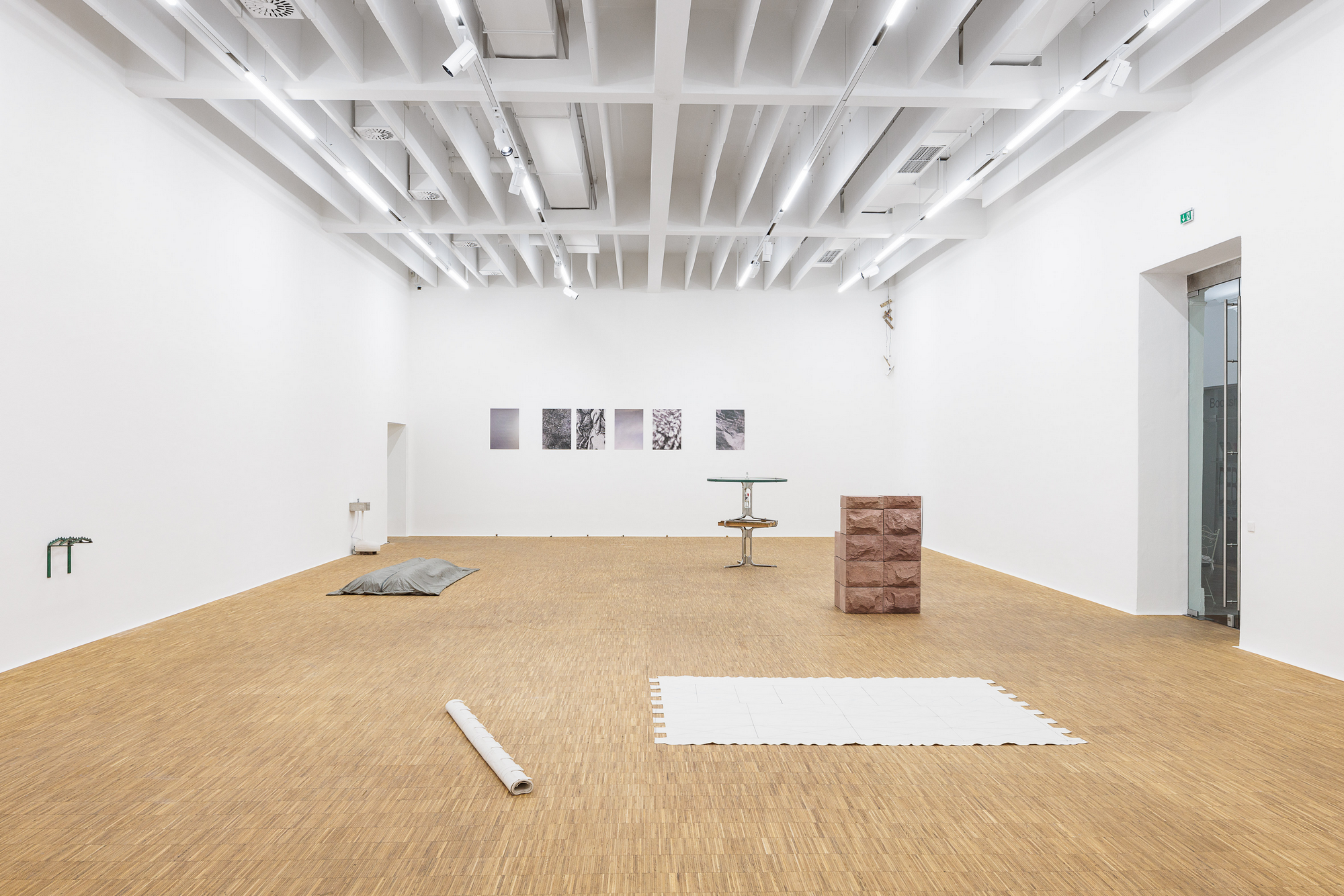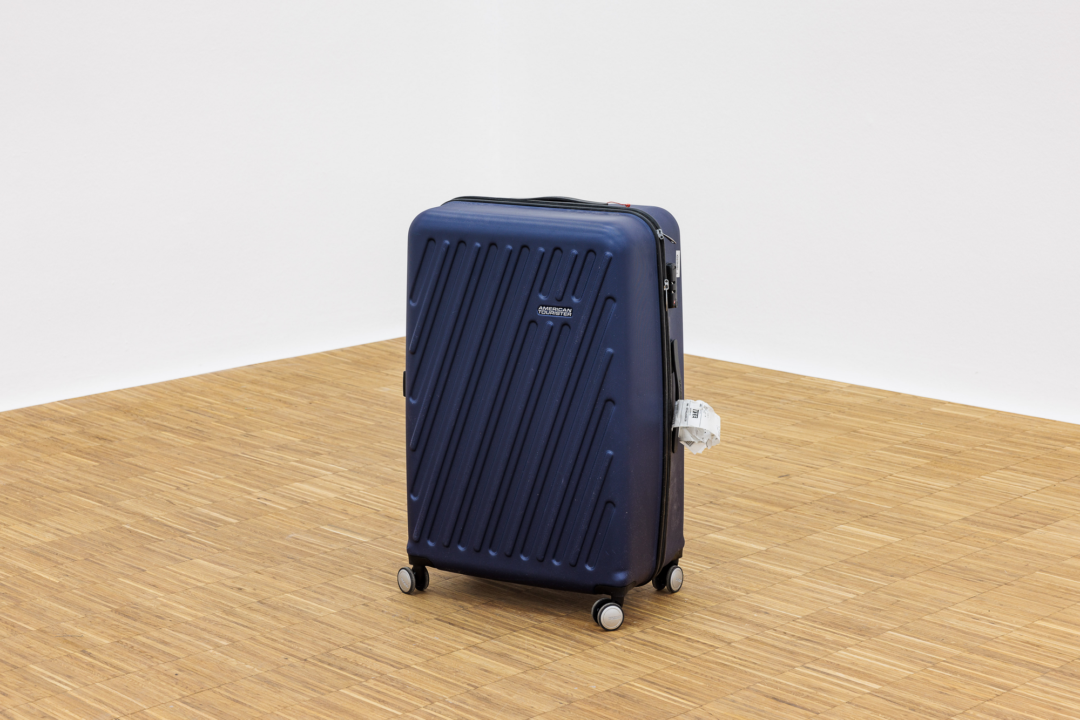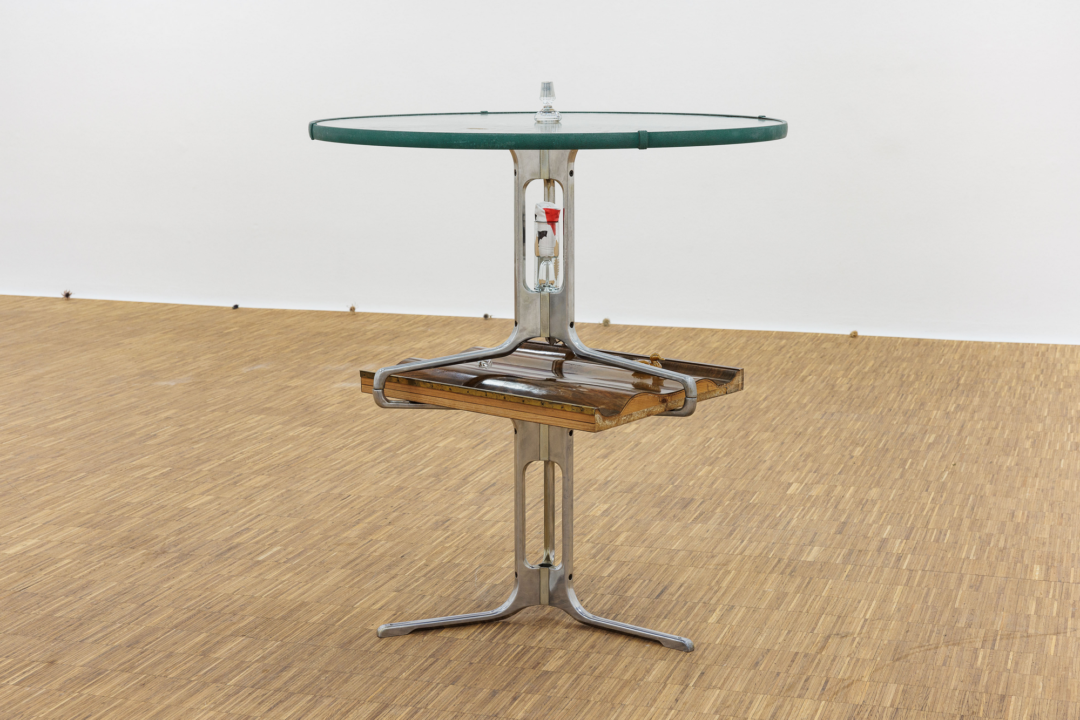Debt

Debt
Salzburger Kunstverein, Salzburg
2024 edition of the annual exhibition of the members of the art centre’s association
curated by Hana Ostan-Ožbolt-Haas
14.12.2024 – 16.02.2025
Ambitiously and meticulously curated by Hana Ostan-Ožbolt-Haas, debt refers to the notion of debt, the precariousness it entails and the notion of accountability. Bringing together anecdote-based and experimental works, and informed by anarchist writings by David Graeber and Elettra Stimilli, the exhibition examines the economic austerity that artists, by their social status and critical standpoint, both anticipate and denounce.
Benjamin Hirte (Aschaffenburg, Germany, former Federal Republic of Germany, 1980)’s Spender (2024), a rather unusual fountain-sculpture in stainless steel and marble dispensing water in a self-contained circuit, is a mockery of public facilities which, lacking maintenance, have become symptoms of political disengagement. His sculptures Shrine (2024), in red sandstone and white lacquer, and Dress (2024) and Cover (2024), in Carrara marble, evoke memorial plaques recalling the ravages of real estate construction and car production, and the fate of humanity bowing under the weight of debt.
Untitled (2022/2024) by Tammy Langhinrichs (Hamburg, Germany, 1995) expands on the aesthetic understanding of debt with compunction and sternness. For a moment, what may have appeared to be a makeshift bedding looks more like the shroud covering an inert body lying on the ground: a disquieting block of dark fabric. The burden of debt leads to social bankruptcy and death. The evocation of a hidden corpse serves as a dramatic double of ourselves, trapped as we are in our inability to escape from the ferocity of debt.
Quoting a 1981 lecture by Gilles Deleuze, du sourd, du teigneux, de la grisaille (2022/2024) by Miriam Stoney (Scunthorpe, UK, 1994) is a set of six posters in dull colours, dialoguing by analogy, flanked by six pungent thistle heads arranged on the floor before each of the posters, serving originally as a warning against sitting or leaning at historical sites. The variations in grey coalesce into a homogeneous, ashen pallor. The banality of everyday life turns out to be more sophisticated than deceptive. The artist also wrote Debt Verses (2022), an eccentric, embedded narrative about debt from the fanciful perspective of a fortune teller, performed as a reading during the exhibition.

Vues de l’exposition / Exhibition views « Debt. Annual Exhibition 2024/2025 », Salzburger Kunstverein 2024. Photos : kunst-dokumentation.
With the limited endlessness (2024) project, the absence of the reference object is marked by the presence of its lines. Based on a cutting scheme to produce boxes, Magdalena Stückler (Neunkirchen, Austria, 1996) has reproduced the drawings on two large, fringed canvases, one lying flat, the other rolled up. The drawings were silk-screened, with each print gradually shaping the whole. The sophistication of the process contrasts with the seeming visual simplicity of the medium. The drawings suggest infinite possibilities, while the canvases are limited to what they can contain: the relentless paradox of what debt is.
Gleb Amankulov (Minsk, Belarus – former USSR, 1988) shows Display on Demand (2024) and Cover II (2024), two works made solely for the context of the exhibition, using borrowed or temporarily purchased objects and fragments. A large plate of glass on a wooden footrest, fixed by two metal shelf holders, is paired with a folded wooden easel, tanned leather leftovers and belts, and pieces of fur. The ensemble evokes a tongue-in-cheek version of Marcel Duchamp’s Le Grand Verre (1915-1923). The latter, a stack of scattered legs, furniture pieces and ornamental objects, suggests a hasty departure. Distinct styles mingle, bringing together the household realm, the momentary present and the wartime in a debt-ridden, afflicted Europe.
Lectern (From One State to Another State) (2024) by Frank Wasser (Dublin, Ireland, 1989), an intriguing blue suitcase, standing upright on its wheels, used and still labelled, is an unexpected tribute, halfway between irony and despair, to a Tate Modern lectern from which the artist once addressed listeners as a means of financial support for his art practice. The piece of luggage, which the artist carried from one country to another, through customs procedures of all kinds, contains the sawdust resulting from the sanding down of the object, turning it from an ordinary piece of furniture into a venerated powder, revealed to the public during his Split (Zero-Hour Fragments) (2024) performance, a frantic soliloquy of his internal, art-related tug-of-war.
Anxiously affected by the hostile, repressive urban planning in New York, David L. Johnson (New York, USA, 1993) smuggled away metal structures that were designed to prevent people from loitering on fire hydrants, and mischievously displays them at their original height. Each title features the first name of the building’s owner: Loiter (Joseph) (2024), Loiter (Corey) (2024), Loiter (Aaon) (2024), Loiter (Seror) (2024). Snow (2014), a sequence shot filmed through the window of a building from a snowy street, is displayed on a monitor on the floor. The artist, torn between obsession and revulsion, watches Jeff Koons and his entourage: a glimpse of embittered loneliness.
The works by Artur Schernthaner-Lourdesamy (Vienna, Austria, 2001), in their inherent humbleness, function as micro-interventions. Corner Gesture (2024), hung at a heigh of several metres in a corner of the Grand Hall, adjoining the ceiling, is a set of six rectangle-shaped MDF panels equipped with a sound system intermittently emitting noise. Fragments (Stored Together) (2024) is an ensemble of eight minimalist sculptures in copper or steel positioned on two windowsills of the Ring Gallery, and Harbour Story (2024), a set of six small, subtitled stills from a video of a twilight desolate setting, on show in the service hall. The artist uses the renewed impediments and constraints of sidelined spaces as the basis for an enigmatic art form that treads a fine line between sensitivity and disruption.
Overcoming the obstacles of didactics and illustration, debt confronts us, through the lens of acute experiences and feelings, with the plight of an unfortunate political time when societies are disintegrating. Hana Ostan-Ožbolt-Haas warns us about the existential threats of debt and urges us to consider the oppression that brutalises vulnerable citizens, to counter it and to substitute its destructive outrageousness with empathy and mutual aid.

Vues de l’exposition / Exhibition views « Debt. Annual Exhibition 2024/2025 », Salzburger Kunstverein 2024. Photos : kunst-dokumentation.
Head image : Vue de l’exposition / Exhibition view « Debt. Annual Exhibition 2024/2025 », Salzburger Kunstverein 2024. Photo : kunst-dokumentation.
Related articles
Thomias Radin
by Caroline Ferreira
Mona Hatoum
by Florence Duchet
After the End. Maps for Another Future
by Guillaume Lasserre